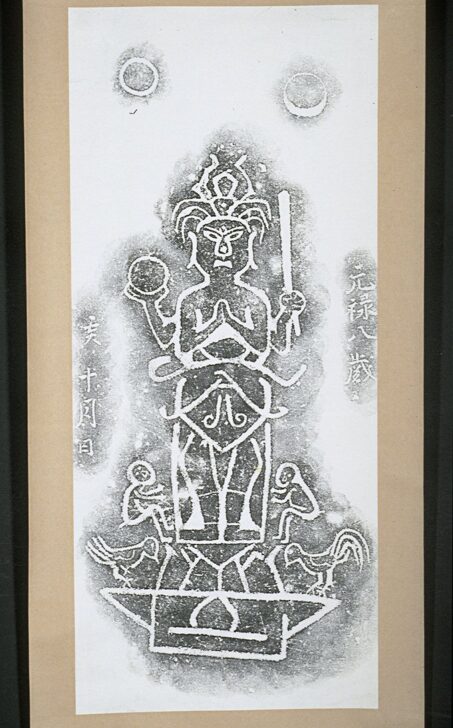Shômen Kongô
Japanese

Description
Rubbings are a common method for recording historic images and calligraphy carved in stone. The technique was commonly used in China, where scholars would transfer
calligraphy from stones onto paper using ink. To do this, paper would be dampened and laid onto the stone surface. A small brush or cotton cloth was then used to press the paper into the depressions in the stone. When ink was brushed or pounded onto the paper, the areas pressed into the stone would be left untouched, making them white against a black background.
This image is a rubbing of the deity Shômen Kongô. He is depicted with four arms, two of which hold a sword and a wheel. He is often accompanied by two servant boys, as he is here, and roosters, who were considered protectors against demons. Behind him are the sun and the moon. Some Buddhist texts say Shômen Kongô was originally a demon who caused illness and tortured humans, but that he dedicated himself to protecting them against disease after a defeat.
The writing on either side of the image indicates the date. The right side of the image reads “the 8th year of the Genroku era,” or 1695.
Spring/Summer Gallery Rotation 2015
Subject Matter:
This image is a rubbing of the deity Shômen Kongô. He is depicted with four arms, two of which hold a sword and a wheel. He is often accompanied by two servant boys, as he is here, and roosters, who were considered protectors against demons. Behind him are the sun and the moon. Some Buddhist texts say Shômen Kongô was originally a demon who caused illness and tortured humans, but that he dedicated himself to protecting them against disease after a defeat. The writing on either side of the image indicates the date. The right side of the image reads “the 8th year of the Genroku era,” or 1695.
Physical Description:
A scowling figure standing atop a pedestal. He has four arms, two of which are clasped together, and the other two of which are holding an orb and a stick. On the pedestal are two small human figures and two birds. Above the figure are two circles. On the right and left side of the image are lines of writing.
Usage Rights:
If you are interested in using an image for a publication, please visit https://umma.umich.edu/request-image/ for more information and to fill out the online Image Rights and Reproductions Request Form.